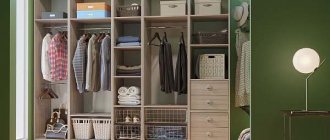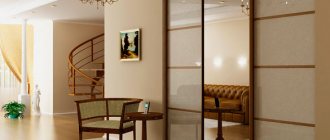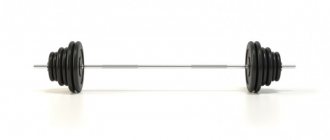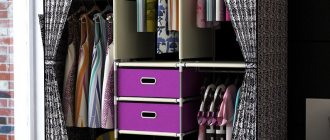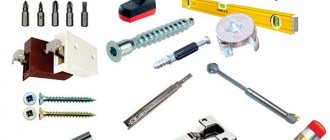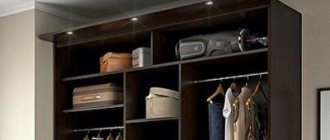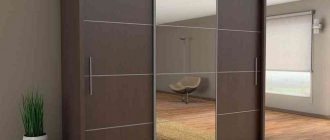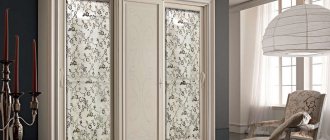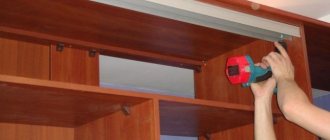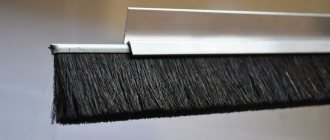8857 0 1
Andrey March 2, 2018 Specialization: facade finishing, interior finishing, construction of dachas, garages. Experience of an amateur gardener and gardener. We also have experience in repairing cars and motorcycles. Hobbies: playing the guitar and many other things that I don’t have time for :)
If you are planning to repair an old cabinet or make a new one from scratch, you will definitely be faced with the choice and installation of a rod. At first glance, this is a simple task, but in reality it contains many nuances. Therefore, I suggest you familiarize yourself with them, which will allow you to independently arrange a comfortable and reliable hanger in your closet.
The rod is a necessary element of any wardrobe
What types of closet rods are there?
There are two types of standard, or typical, cabinet rods (named after the profile shape):
- oval is the most typical; most of the cabinets are equipped with these rods. The oval shape is not accidental: it allows it to withstand more severe loads than the round one. Mounted on specially shaped rod holders.
- round - usually a chrome-plated pipe with a diameter of 25 mm, secured with flanges. It holds weight well, but is inferior in reliability to a similar oval barbell. For this reason, its length, as a rule, does not exceed 60 cm.
Cabinet rods are made from the following materials:
- aluminum is a lightweight and durable material. Used for light items (shirts, trousers, belts, ties), as it does not withstand heavy loads.
- Chrome steel is a very durable material, suitable for clothing of any size and weight. If the hanger hooks are made of metal, they can scratch the chrome plating and cause the rod to rust. Therefore, it should only be combined with plastic or wooden hooks.
- wood is a classic material that has both advantages (pleasant appearance and durability) and significant disadvantages: gradual sagging under the influence of the weight of clothing and moisture, as well as the formation of dents from hanging hangers for a long time. Nowadays it is rarely used;
- plastic is lightweight and visually attractive, suitable only for light clothing. It is rare and, as a rule, in inexpensive cabinets.
Different models of cabinets use longitudinal (pantograph lift) or transverse (microlift) rods. Standard rods are installed using both the first and second methods. Almost all types of rods can be found on sale in Ikea stores.
Not all crossbars have a strictly straight shape. Some cabinets use L-shaped standard rods with an oval profile, one end attached to the wall and the other to the adjacent wall or top shelf.
Using a pull-out rod allows you to make the cabinet flatter and more convenient for placement in small rooms. Professional furniture makers call this type of rod a “microlift.”
A separate subtype of the retractable rod is the “pantograph lift,” which extends in the vertical direction, that is, from top to bottom. The pantograph bar can be smoothly lowered and raised thanks to a hydraulic mechanism. When lowered, the bar is firmly fixed, so there is no need to support it with your hands when hanging or removing clothes.
A retractable microlift, or trombone, is often used as a transverse rod. The length of the microlift can be changed thanks to a retractable mechanism. With a large amount of stored clothing, the microlift makes it difficult to access things located at the back wall of the closet.
The microlift is attached to the closet with only four small screws, so if you intend to store a large amount of clothing, such a rod is clearly not the best option. Installing more solid fasteners or replacing the microlift with a standard rod with a round or oval profile allows you to achieve greater reliability and stability.
A standard barbell, no matter how impressive it looks, should also not be overloaded, since every barbell has a limited safety margin.
Some rods are equipped with lights, making it easier to find clothes in the dark. Holes are made in the pipe into which LEDs are inserted; sometimes built-in fluorescent lamps are used.
Practical materials
According to the production technology of clothing storage devices, all materials must be durable and reliable. Constant high load gradually pushes the bar, which can lead to its breakage. To prevent a sad outcome, it is recommended to take a closer look at the materials for the production of floor and hanging rods:
- Chrome steel is the most common material for clothing storage devices. The raw materials are highly reliable and can withstand heavy loads for a long time. If you install the product correctly, choosing the length of the rod correctly, it will last for many years without a single scratch;
- metal alloys - used for the production of rods for commercial purposes. For example, metal fixtures are well suited for organizing the storage of theatrical costumes, and can also serve as clothing racks in a store. Such a rod will be highly durable, but the appearance will not be attractive due to the lack of coating;
- galvanized steel. The production technology makes it possible to apply a special coating to the steel material, protecting the product from wear and corrosion. A hanging place for storing ties and scarves can be made from this material.
The method of installing the rod will depend on the parameters of the closet or dressing room. If it is narrow and small, it makes sense to use a longitudinal fastening. If the cabinet has good depth, you can perform a transverse installation.
Dimensions of clothing rails
To choose the optimal location for the rod, you need to start from two factors - the width and depth of the closet section intended for hangers with clothes. Longitudinal installation is possible only in cabinets with a depth of at least 530 mm. Even if the cabinet depth is 480 or 460 mm, it will not allow standard hangers to be placed longitudinally.
In closets with a depth not exceeding 50-55 cm, hangers with clothes can only be placed parallel to the back wall of the closet. Standard lengths of retractable rods are 500 and 250 mm.
Types of structures
There is a regular stick for hangers, which is installed from wall to wall of furniture. This is a classic option, which is used to store clothes in most cases.
But there are also other types of structures.
- Retractable
. Relevant for structures that have a depth of up to 50 cm. Mounted perpendicular to the ceiling of the cabinet. One part slides out;
Pull-out systems are suitable for cabinets with a depth of less than 550 mm
- For accessories
. Such accessories are intended for belts, ties, as well as scarves and other elements. Most often they are attached to doors. For sliding wardrobes this is the side inner wall;
Such designs are ideal for storing ties, belts and other accessories.
- Pantograph
. This is a folding bar called a cabinet pantograph. Fixed on the side sections. The mechanism works on the principle of an elevator. That’s why it’s also called a microlift. Lowers to a comfortable level. Relevant for high ceiling furniture;
Pantograph - a convenient solution for tall cabinets
- For trousers
. Special rods that provide order when storing a large number of pants, trousers, and jeans.
If you have a lot of trousers, it’s worth installing this type of rod in your closet.
No one bothers you to equip furniture with several designs at once. Look through the catalog, go to the store or the manufacturer’s website. See what you can buy and install as filling. Thoughtful internal filling of the wardrobe will give you more options.
At what height should the barbell be hung?
Pantograph bars allow hangers to be placed under the ceiling without the need to stand on tiptoes or on a chair. They are often used in tall wardrobes or wardrobes and allow you to hang not too long clothes in two or more tiers.
Standard rods can also be installed in 2 or more levels, but their use is associated with obvious inconveniences.
How to install a clothes rail in a closet
To install the rod, you need to do a few simple steps:
- apply markings: attach the fasteners to the walls, making a small indent from the top shelf, then mark with a pencil the contours of the fasteners and the locations for the holes;
- drill holes of the required depth using a drill stop or wrapping electrical tape around the drill;
- attach the fasteners to the outlined contours and screw in the screws.
How to make a closet rod with your own hands
When making your own closet, the rods need to be selected and placed so that the weight of the clothes placed on them does not exceed their capabilities, and the closet space is used as rationally as possible.
It is important that the rod rests entirely on the supporting planes of the holder. To calculate the length of the rod, you need to subtract a gap of 5-6 millimeters from the distance between the opposite walls. For example, if the distance between the walls is 600 mm, then the length of the rod will be 600 - 6 = 594 mm. The rod mounts are marked horizontally in the middle of the wall, measuring the distance using a tape measure.
The easiest way to choose a material is wood that is durable and easy to process. You can take an ordinary gymnastics stick or cut a round or oval barbell yourself using a plane or knife. All excess from the sides is sawed off from the finished stick, the surface is cleaned with sandpaper, degreased and, if desired, varnished. The fastening can also be made from what is at hand. For example, a regular beer stopper is suitable for this purpose.
It’s even easier to purchase a ready-made steel pipe, the necessary fasteners and screws in the store. To adjust it to the desired length, all excess is sawed off with a hacksaw.
If the cabinet already has rod holders, first of all pay attention to whether they have a round or oval cross-section and whether they have a thread. If there is a thread on the inner surface of the fasteners, you need to measure its diameter and depth and subsequently cut the same thread on the rod using a thread cutter. To make it easier to screw in the threaded rod, you should slightly increase the gap between its ends and the cabinet walls.
Purpose and features
To ensure that the wardrobe is easy to use and does not allow clothes to become wrinkled, it is provided with a hanger. Its main element is a bar (crossbar), on which trempels (hangers) or clothing itself are usually hung. The crossbar is a pipe that is most often attached to the walls of furniture.
Often, several rods are installed at different levels in one section of the cabinet. This saves space and reduces the number of shelves. The latter in this case will be occupied only with shoes and all sorts of small things.
Barbells allow you to reduce the number of shelves to a minimum
The main requirement for any barbell is load-bearing capacity. It must support the weight of all the clothes that will hang on it. In addition, the hanger should be positioned so that the closet space is used efficiently.
